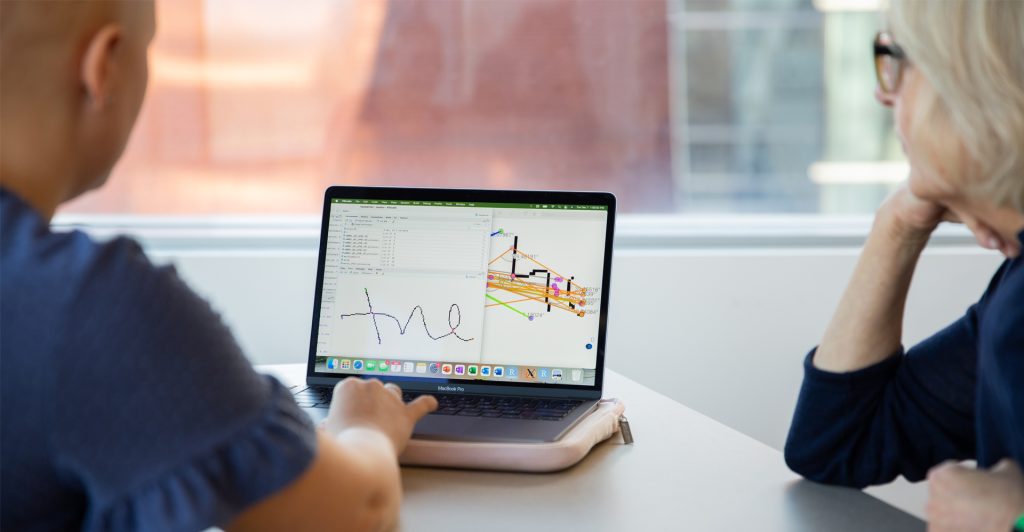Alexandra Arabio, an Iowa State University statistics graduate student, was invited to present a poster at the American Society of Questioned Document Examiners (ASQDE) 81st Annual Conference. The conference will be held Aug. 7-9 in New York City.

Arabio is a graduate research assistant at the Center for Statistics and Applications in Forensic Evidence (CSAFE) and studies under Alicia Carriquiry, CSAFE director and Distinguished Professor and President’s Chair in Statistics at Iowa State, and Danica Ommen, a CSAFE researcher and associate professor of statistics at Iowa State.
Her poster, “Quantifying Writer Variance Through Rainbow Triangle Graph Decomposition,” provides results from Arabio’s study where features of handwriting are examined through point decomposition and rainbow triangulation. Her project aims to impact the forensic community by demonstrating a new method for analyzing handwriting that could be used in junction with current practices to better quantify and support results regarding the source of a questioned document. An abstract of her poster is provided below.
Arabio will give a short introduction about her poster to attendees on Aug. 7, and her poster will be on display throughout the conference. Only six posters were accepted to be presented at this year’s conference.
The ASQDE conference is held annually to explore topics and techniques related to forensic document examination. This year’s theme is “Pushing Boundaries: A Look into the Unusual, Uncommon and Unexpected in QD,” and will include workshops, panel discussions, poster and exhibit displays, and trainee breakout sessions.
For more information about the ASQDE, visit https://www.asqde.org.
Learn more about CSAFE’s work on handwriting analysis and find discipline-specific publications and webinars at https://forensicstats.org/handwriting-analysis.
Quantifying Writer Variance Through Rainbow Triangle Graph Decomposition
Presenting Author: Alexandra Arabio
Co-authors: Danica Ommen and Alicia Carriquiry
View Poster»Abstract: Handwriting comparative analysis is based on the principle that no two individuals can produce the same writing and that an individual cannot exactly reproduce his/her handwriting. This project aims to assess and quantify the natural variations produced by a distinct writer. In an attempt to support traditional examination with objective measures, this project provides results from a study where features of handwriting are examined through point decomposition and rainbow triangulation.
Using this method to examine handwriting samples, more specific information can be obtained from each exemplar and can be standardized to be compared both within a writer and between different writers. The characteristics or landmarks of each handwriting sample that gets marked as a different color node include the location where a pen stroke begins (marked blue), the location where a pen stroke ends (marked orange), and any location where a pen line overlaps itself (marked pink), the highest location that a pen stroke reaches (marked green), the lowest location that a pen stroke reaches (marked purple). Triangles can provide information on angles, edge slopes, edge lengths, and areas that all prove useful for quantitative analysis and when trying to compare triangles in terms of similarity and possible congruency or similarity.
By forming rainbow triangles over these samples, it is possible to gauge the variation within a single writer and to compare these quantitative values to other samples of unknown sources. Rainbow triangles are formed so that each vortex or node within a triangle set has a unique color, and each edge is unique to its triangle so that it is not to be used to form a different triangle in another set. Using this information, the study aims to form a quantitative analysis of handwriting samples and to calculate how similar or dissimilar two samples are from one another. One of the study’s main goals is to form these triangles from multiple samples from several different writers and to group, identify, and accurately determine what samples came from which writer. Finally, multiple summary statistics are explored to determine whether any can be used to discriminate between inclusions and exclusions using data where ground truth is known, such as a true match. This project hopes to impact the forensic community by demonstrating a new method for analyzing handwriting that could be used in junction with current practices to better quantify and support results regarding the source of a questioned document.




